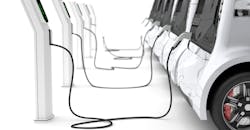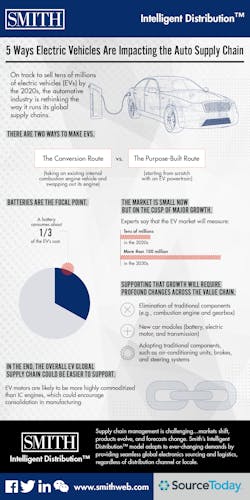5 Ways Electric Vehicles are Impacting the Auto Supply Chain
As internal combustion engines continue to give way to more environmentally-conscious alternatives, all eyes are on the electric vehicle and how it’s impacting the automotive supply chain. “Although it is not yet completely certain which type of technology will win the race to replace [gas] or diesel engines,” Research and Markets points out in “Future Mobility: Electric Vehicle Supply Chain Architecture,” “it is clear that electric vehicles will play an important, even defining, role in the industry’s future.”
The research firm goes on to say that any shift in the automotive supply chain impacts not only the companies, their suppliers, and their logistics service providers, but also entire economies. “Any change in the structure of the automotive supply chain,” it points out, “has the power to affect the nature of world trade and the dynamics of numerous national economies.”
Here are five things electronics buyers should know about the electric vehicle’s (EV) impact on the auto supply chain:
- There are two ways to make EVs. The EV supply chain will be quite different from the one that is used to produce internal combustion engine (ICE) vehicles, David Fessler points out in “How the Switch to EVs Is Causing Problems for Carmakers.” Just how different depends on which design concept a manufacturer adopts. There are two options: the conversion route (taking an existing ICE vehicle and swapping out its engine) or the purpose-built route (starting from scratch with an EV powertrain). “A supply chain for a conversion EV will be the same as that of an ICE vehicle but with additional EV parts,” Fessler writes. “A supply chain for a purpose-built EV, on the other hand, will be as different as the EV itself.”
- Batteries are the focal point. They’re heavy, cover the entire floor of the vehicle, and eat up about one-third of the EV’s cost. “As a result of their size and weight, EV battery packs have big implications for both logistics and supply chains,” Fessler adds, nothing that Tesla makes its own proprietary battery packs and battery cells in-house. To further simplify logistics, the electric vehicle manufacturer also produces its own motors. Outside of Tesla, most lithium-ion battery production takes place in Asia, Fessler adds.
- The market is small now, but on the cusp of major growth. Today, electric vehicles account for only about 0.1% of the global vehicle stock and less than 1% of sales, Automotive Logistics reports. Volume growth in SUVs and trucks, while lower in percentage terms, has had a bigger impact on the market. “However, if the world’s major economies are to meet climate change commitments, a large chunk of the market will need to switch over to electric propulsion,” the publication points out, noting that deployment targets vary, but experts say that the EV market will measure in the tens of millions by the 2020s (and more than a 100 million by the 2030s).
- Supporting that growth will require profound changes across the value chain. When the EV trend kicks into full swing, everything from technology to manufacturing systems to ownership models to aftermarket support will need a major overhaul. For example, supply chains for conversion EVs look like conventional ones with extra elements added, Automotive Logistics reports, while supply chains for purpose design EVs often look “radically different.” Key changes include the elimination of traditional components (i.e., combustion engine and gearbox); new car modules (battery, electric motor, and transmission); and adapting traditional components such as air-conditioning units, brakes, and steering systems.
- In the end, the overall EV global supply chain could be easier to support. Batteries aside, EV components are lighter and more easily managed than those used in their IC counterparts. “That has implications for supply chains,” Automotive Logistics points out. For example, EV motors are likely to be more highly-commoditized than IC engines, and with limited opportunity for manufacturers to use motor technology as a point of competitive differentiation. “That could encourage outsourcing and consolidation in manufacturing,” the publication notes, “and make global supply chains easier to support.”


